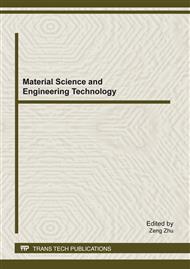[1]
F. Anzani, D. Bosisio, M. Matteucci and D. G. Sorrenti: On-Line Color Calibration in Non-Stationary Environments. The Ninth International RoboCup Symposium, Osaka, Japan, (2005).
DOI: 10.1007/11780519_35
Google Scholar
[2]
Sridharan M. and Stone P.: Towards illumination invariance in the legged league. The Eighth International RoboCup Symposium, Springer-Verlag, Berlin Heidelberg, p.196–208, (2005).
DOI: 10.1007/978-3-540-32256-6_16
Google Scholar
[3]
M. Jüngel, J. Hoffmann, and M. Lotzsch: A real-time auto-adjusting vision system for robotic soccer. 7th International Workshop on RoboCup 2003 (Robot World Cup Soccer Games and Conferences), Lecture Notes in Artificial Intelligence, Springer, (2004).
DOI: 10.1007/978-3-540-25940-4_19
Google Scholar
[4]
Parameswaran Vasu, Singh Maneesh and Ramesh Visvanathan: Illumination Compensation Based Change Detection Using Order Consistency. 23rd IEEE Conference on Computer Vision and Pattern Recognition. San Francisco, USA, p.1982 – 1989, (2010).
DOI: 10.1109/cvpr.2010.5539873
Google Scholar
[5]
G. Sapiro: Color and illuminant voting. IEEE Transactions on Pattern Analysis and Machine Intelligence, Vol. 21, no. 11, pp.1210-1215, (1999).
DOI: 10.1109/34.809114
Google Scholar
[6]
Neves. A, Corrente. G and Pinho. A: An omnidirectional vision system for soccer robots. Progress in artificial intelligence. Lecture notes in artificial intelligence, vol. 4874, Springer, pp.499-507, (2007).
DOI: 10.1007/978-3-540-77002-2_42
Google Scholar
[7]
S. Fidler, and A. Leonardis: Towards Scalable Representations of Object Categories: Learning a Hierarchy of Parts. The International Conference on Computer Vision and Pattern Recognition (CVPR), (2007).
DOI: 10.1109/cvpr.2007.383269
Google Scholar
[8]
Sridharan M. and Stone P.: Color Learning and Illumination Variance on Mobile Robots: A Survey. Robotics and Autono- mousSystem, Vol. 75(1), pp.1-38, (2009).
Google Scholar
[9]
S. Thrun, W. Burgard and D. Fox, Probabilistic Robotics, MIT Press, Cambridge, USA, (2005).
Google Scholar
[10]
J. E. Bresenham: Algorithm for computer control of a digital plotter. IBM Systems J., Vol 4(1), p.25–30, (1965).
DOI: 10.1147/sj.41.0025
Google Scholar
[11]
Xin Luan, Wei-Wei Qi, Da-Lei Song, Ming Chen, Tie-Yi Zhu and Li Wang: Illumination Invariant Color Model for Object Recognition in Robot Soccer. Advances in Swarm Intelligence. Lecture Notes in Computer Science, Springer, Vol. 6146/2010, pp.680-687, (2010).
DOI: 10.1007/978-3-642-13498-2_89
Google Scholar


